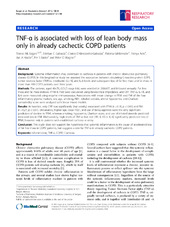| dc.relation.haspart | Background Systemic inflammation may contribute to cachexia in patients with chronic obstructive pulmonary disease (COPD). In this longitudinal study we assessed the association between circulating C-reactive protein (CRP), tumor necrosis factor (TNF)-α, interleukin (IL)-1ß, and IL-6 levels and subsequent loss of fat free mass and fat mass in more than 400 COPD patients over three years. Methods The patients, aged 40–76, GOLD stage II-IV, were enrolled in 2006/07, and followed annually. Fat free mass and fat mass indexes (FFMI & FMI) were calculated using bioelectrical impedance, and CRP, TNF-α, IL-1ß, and IL-6 were measured using enzyme immunoassays. Associations with mean change in FFMI and FMI of the four inflammatory plasma markers, sex, age, smoking, FEV1, inhaled steroids, arterial hypoxemia, and Charlson comorbidity score were analyzed with linear mixed models. Results At baseline, only CRP was significantly (but weakly) associated with FFMI (r = 0.18, p < 0.01) and FMI (r = 0.27, p < 0.01). Univariately, higher age, lower FEV1, and use of beta2-agonists were the only significant predictors of decline in FFMI, whereas smoking, hypoxemia, Charlson score, and use of inhaled steroids predicted increased loss in FMI. Multivariately, high levels of TNF-α (but not CRP, IL-1ß or IL-6) significantly predicted loss of FFMI, however only in patients with established cachexia at entry. Conclusion This study does not support the hypothesis that systemic inflammation is the cause of accelerated loss of fat free mass in COPD patients, but suggests a role for TNF-α in already cachectic COPD patients. | en_US |

